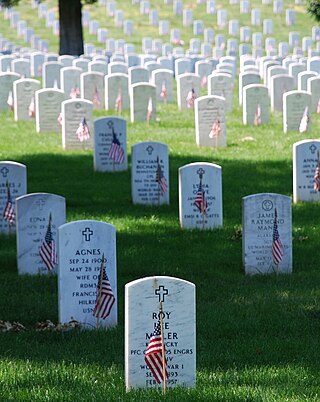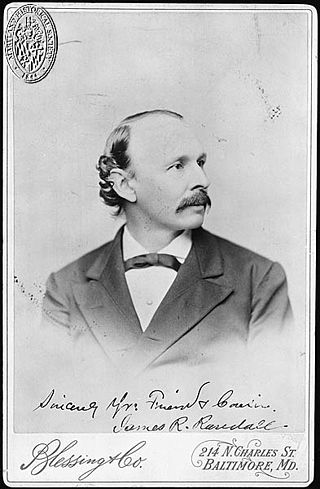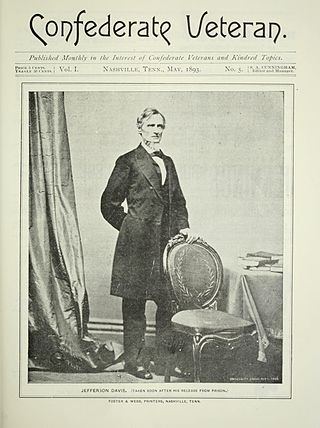
The Confederate States of America (CSA), commonly referred to as the Confederate States or the Confederacy, was an unrecognized breakaway republic in the Southern United States that existed from February 8, 1861, to May 9, 1865. The Confederacy comprised U.S. states that declared secession and warred against the United States during the American Civil War: South Carolina, Mississippi, Florida, Alabama, Georgia, Louisiana, Texas, Virginia, Arkansas, Tennessee, and North Carolina. Kentucky and Missouri also declared secession and had full representation in the Confederate Congress, though their territory was largely controlled by Union forces after 1862.

Memorial Day is a federal holiday in the United States for mourning the U.S. military personnel who have died while serving in the United States armed forces. It is observed on the last Monday of May. From 1868 to 1970 it was observed on May 30.

Sidney Clopton Lanier was an American musician, poet and author. He served in the Confederate States Army as a private, worked on a blockade-running ship for which he was imprisoned, taught, worked at a hotel where he gave musical performances, was a church organist, and worked as a lawyer. As a poet he sometimes used dialects. Many of his poems are written in heightened, but often archaic, American English. He became a flautist and sold poems to publications. He eventually became a professor of literature at the Johns Hopkins University in Baltimore, and is known for his adaptation of musical meter to poetry. Many schools, other structures and two lakes are named for him, and he became hailed in the South as the "poet of the Confederacy". A 1972 US postage stamp honored him as an "American poet".

The United Daughters of the Confederacy (UDC) is an American neo-Confederate hereditary association for female descendants of Confederate Civil War soldiers engaging in the commemoration of these ancestors, the funding of monuments to them, and the promotion of the pseudohistorical Lost Cause ideology and corresponding white supremacy.

The flags of the Confederate States of America have a history of three successive designs during the American Civil War. The flags were known as the "Stars and Bars", used from 1861 to 1863; the "Stainless Banner", used from 1863 to 1865; and the "Blood-Stained Banner", used in 1865 shortly before the Confederacy's dissolution. A rejected national flag design was also used as a battle flag by the Confederate Army and featured in the "Stainless Banner" and "Blood-Stained Banner" designs. Although this design was never a national flag, it is the most commonly recognized symbol of the Confederacy.

Henry Timrod was an American poet, often called the "Poet of the Confederacy".

"Maryland, My Maryland" was the state song of the U.S. state of Maryland from 1939 until 2021. The song is set to the melody of "Lauriger Horatius" — the same tune "O Tannenbaum" was taken from. The lyrics are from a nine-stanza poem written by James Ryder Randall (1839–1908) in 1861. The state's general assembly adopted "Maryland, My Maryland" as the state song on April 29, 1939.

"God Save the South" is a poem-turned-song written by American George Henry Miles, under the pen name Earnest Halphin, in 1861. It is considered by some to have been the unofficial national anthem of the Confederate States of America. The commonly heard version was composed by Charles W. A. Ellerbrock, while C. T. De Cœniél later composed a different tune for the song.

The Lost Cause of the Confederacy is an American pseudohistorical negationist mythology that claims the cause of the Confederate States during the American Civil War was just, heroic, and not centered on slavery. First enunciated in 1866, it has continued to influence racism, gender roles, and religious attitudes in the South to the present day.
The most common name for the American Civil War in modern American usage is simply "The Civil War". Although rarely used during the war, the term "War Between the States" became widespread afterward in the Southern United States. During and immediately after the war, Northern historians often used the terms "War of the Rebellion" and "Great Rebellion", and the Confederate term was "War for Southern Independence", which regained some currency in the 20th century but has again fallen out of use. The name "Slaveholders' Rebellion" was used by Frederick Douglass and appears in newspaper articles. "Freedom War" is used to celebrate the war's effect of ending slavery.

James Ryder Randall was an American journalist and poet. He is best remembered as the author of "Maryland, My Maryland".

Abram Joseph Ryan was an American poet, Catholic priest, Catholic newspaper editor, orator, and former Vincentian. An active proponent of the Confederate States of America, he has been called the "Poet-Priest of the South" and the "Poet Laureate of the Confederacy."

The Great War: Walk in Hell is the second book in the Great War series of alternate history books by Harry Turtledove. It is also the third part of the Southern Victory. It takes the Southern Victory Series from 1915 to 1916.

The Roman Catholic Church of the Immaculate Conception is a historic church located at 414 West Vine on Summit Hill in Knoxville, Tennessee.

The Ladies' Confederate Memorial is an American Civil War monument erected in 1874 in Lexington Cemetery in Lexington, Kentucky. It was placed on the National Register of Historic Places on July 17, 1997, as part of the Civil War Monuments of Kentucky MPS. Unlike most Confederate monuments in Kentucky, it represents grief rather than Southern patriotism.

The Confederate Veteran was a magazine about veterans of the Confederate States Army during the American Civil War of 1861–1865, propagating the myth of the Lost Cause of the Confederacy. It was instrumental in popularizing the legend of Sam Davis. A subsequent magazine of the same title is still in print, and is an official publication of the Sons of Confederate Veterans organization.

During the American Civil War, music played a prominent role on both sides of the conflict, Union and Confederate. On the battlefield, different instruments including bugles, drums, and fifes were played to issue marching orders or sometimes simply to boost the morale of one's fellow soldiers. Singing was also employed not only as a recreational activity but as a release from the inevitable tensions that come with fighting in a war. In camp, music was a diversion away from the bloodshed, helping the soldiers deal with homesickness and boredom. Soldiers of both sides often engaged in recreation with musical instruments, and when the opposing armies were near each other, sometimes the bands from both sides of the conflict played against each other on the night before a battle.
"Boston Hymn" is a poem by the American essayist and poet Ralph Waldo Emerson. Emerson composed the poem in late 1862 and read it publicly in Boston Music Hall on January 1, 1863. It commemorates the Emancipation Proclamation issued earlier that day by President Abraham Lincoln, tying it and the broader campaign for the abolition of slavery to the Puritan notion of sacred destiny for America.
Anna Peyre Dinnies was a 19th-century American poet and miscellaneous writer. Under the pen name of "Moina", both before and after her marriage, she wrote many poems which attracted attention, of which "Chrysanthemum" was one of the better-known. She contributed to the leading periodicals of the South.

Francis Orray Ticknor was an American doctor and poet. From the state of Georgia, he became known as a war poet, mostly through the fame he acquired with the ballad "Little Giffen".
















